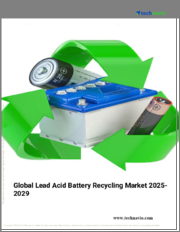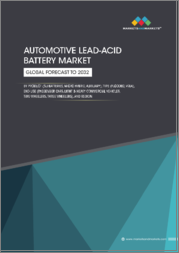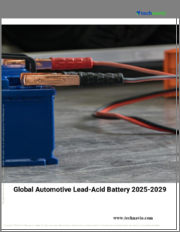
|
시장보고서
상품코드
1684672
납축전지 재활용 시장 : 기회, 성장 촉진요인, 산업 동향 분석(2025-2034년)Lead Acid Battery Recycling Market Opportunity, Growth Drivers, Industry Trend Analysis, and Forecast 2025 - 2034 |
||||||
세계의 납축전지 재활용 시장은 2024년 121억 달러로 평가되었으며, 2025년부터 2034년까지의 CAGR은 9%를 나타낼 전망입니다.
이 역동적인 시장은 납, 황산, 플라스틱을 포함한 필수 재료를 회수하기 위해 사용한 납축전지(ULAB)를 수거하고 처리하는 데 중점을 두고 있습니다. 재활용 공정에는 일반적으로 배터리 구성 요소를 분해하고, 납과 그 화합물을 추출하고, 황산을 중화시키고, 향후 사용을 위해 플라스틱 케이스를 재활용하는 과정이 포함됩니다. 업계에서 지속 가능성을 우선시함에 따라 효과적인 재활용 솔루션의 중요성이 계속 부각되고 있으며, 이 시장은 글로벌 환경 전략의 핵심 요소로 자리 잡고 있습니다.

부적절한 배터리 폐기와 관련된 환경 위험에 대한 인식이 높아지는 것이 시장 확대의 주요 원동력입니다. 납과 황산은 책임감 있게 관리하지 않으면 토양과 물을 심각하게 오염시켜 장기적인 생태 및 건강 위험을 초래할 수 있습니다. 재활용은 이러한 위험을 완화하고 에너지 집약적이고 환경에 해로운 것으로 알려진 새로운 납 채굴의 필요성을 최소화합니다. 납과 플라스틱과 같은 귀중한 재료를 재사용함으로써 재활용 공정는 글로벌 지속가능성 목표에 더욱 부합합니다. 정부의 규제와 친환경 실천에 대한 소비자들의 지지가 높아지면서 전 세계적으로 납축전지 재활용의 도입이 가속화되고 있습니다.
| 시장 범위 | |
|---|---|
| 시작 연도 | 2024년 |
| 예측 연도 | 2025-2034년 |
| 시작 금액 | 121억 달러 |
| 예측 금액 | 286억 달러 |
| CAGR | 9% |
습식 제련 공정은 2034년까지 170억 달러를 창출할 것으로 예상되며, 업계의 판도를 바꿀 새로운 기술로 떠오르고 있습니다. 환경적, 경제적 이점을 제공하는 이 방법은 납과 코발트, 니켈과 같은 기타 귀금속을 효율적으로 회수할 수 있습니다. 에너지 효율성 및 비용 효율성과 결합된 높은 재료 수율로 인해 재활용 시설에서 널리 채택되고 있습니다. 업계가 지속 가능하고 수율이 높은 재활용 방법을 선호함에 따라 향후 몇 년 동안 습식 제련 공정이 주류를 이룰 것으로 예상됩니다.
재활용 납축전지의 고정식 용도는 안정적인 에너지 저장 솔루션에 대한 수요 증가에 힘입어 2034년까지 9.3%의 강력한 연평균 성장률(CAGR)로 성장할 것으로 예상됩니다. 이러한 배터리는 백업 전력 시스템과 태양열 및 풍력 에너지 저장을 포함한 재생 에너지 용도에 매우 중요합니다. 배터리 수명을 연장하고 비용 효율적인 공정을 보장하는 첨단 재활용 기술의 발전으로 고정식 용도에서 배터리 채택이 증가하고 있습니다. 배터리 재활용의 혁신이 계속됨에 따라 제조업체들은 더 많은 재활용 소재를 제품에 통합하여 업계 성장을 더욱 지원하고 있습니다.
미국의 납축전지 재활용 시장은 2034년까지 37억 달러에 달할 것으로 예상됩니다. 이러한 성장은 책임감 있는 배터리 폐기 및 재활용을 의무화하는 엄격한 환경 규제가 뒷받침하고 있습니다. 특히 백업 전력과 재생 에너지 통합을 위해 주거, 상업 및 산업 부문에서 에너지 저장 솔루션에 대한 수요가 증가하면서 시장 확대에 박차를 가하고 있습니다. 이러한 추세는 배터리 재활용 부문에서 지속 가능성과 효율적인 자원 활용에 대한 중요성이 점점 더 강조되고 있음을 강조합니다.
목차
제1장 조사 방법과 조사 범위
- 시장의 정의
- 기본 추정과 계산
- 예측 계산
- 1차 조사와 검증
- 1차 정보
- 데이터 마이닝 소스
- 시장 정의
제2장 주요 요약
제3장 업계 인사이트
- 업계 에코시스템
- 규제 상황
- 업계에 미치는 영향요인
- 성장 촉진요인
- 업계의 잠재적 위험 및 과제
- 성장 가능성 분석
- Porter's Five Forces 분석
- PESTEL 분석
제4장 경쟁 구도
- 소개
- 전략 대시보드
- 혁신과 기술의 전망
제5장 시장 규모와 예측 : 공정별(2021-2034년)
- 주요 동향
- 건식 제련
- 습식 제련
- 물리적/기계적
제6장 시장 규모와 예측 : 용도별(2021-2034년)
- 주요 동향
- SLI
- 거치형
- 기타
제7장 시장 규모와 예측 : 지역별(2021-2034년)
- 주요 동향
- 북미
- 미국
- 캐나다
- 유럽
- 영국
- 스페인
- 독일
- 프랑스
- 아시아태평양
- 중국
- 한국
- 일본
- 인도
- 세계 기타 지역
제8장 기업 프로파일
- Amara Raja
- Aqua Metals
- Cirba Solutions
- East Penn Manufacturing Company
- EnerSys
- Exide
- Glencore
- GME Recycling
- Gravita India
- Umicore
- Yuasa Battery
The Global Lead Acid Battery Recycling Market, valued at USD 12.1 billion in 2024, is poised for significant growth, with projections indicating a 9% CAGR from 2025 to 2034. This dynamic market centers on the collection and processing of used lead acid batteries (ULABs) to recover essential materials, including lead, sulfuric acid, and plastic. The recycling process typically involves dismantling battery components, extracting lead and its compounds, neutralizing sulfuric acid, and repurposing plastic casings for future use. As industries prioritize sustainability, the importance of effective recycling solutions continues to gain traction, making this market a critical component of global environmental strategies.

The rising awareness of the environmental risks associated with improper battery disposal is a major driver of market expansion. Lead and sulfuric acid, if not managed responsibly, can severely contaminate soil and water, posing long-term ecological and health hazards. Recycling mitigates these dangers and minimizes the need for new lead mining, an activity known for its energy-intensive and environmentally damaging nature. By reusing valuable materials, such as lead and plastic, the recycling process further aligns with global sustainability goals. With increasing government regulations and consumer advocacy for greener practices, the adoption of lead acid battery recycling is accelerating worldwide.
| Market Scope | |
|---|---|
| Start Year | 2024 |
| Forecast Year | 2025-2034 |
| Start Value | $12.1 Billion |
| Forecast Value | $28.6 Billion |
| CAGR | 9% |
The hydrometallurgical process is emerging as a game-changer in the industry, projected to generate USD 17 billion by 2034. Offering notable environmental and economic advantages, this method ensures efficient recovery of lead and other valuable metals like cobalt and nickel. Its higher material yield, combined with energy efficiency and cost-effectiveness, is driving widespread adoption among recycling facilities. As the industry leans towards sustainable and high-yield recycling methods, hydrometallurgical processes are expected to dominate in the coming years.
Stationary applications of recycled lead acid batteries are set to grow at a robust CAGR of 9.3% through 2034, driven by increasing demand for reliable energy storage solutions. These batteries are critical for backup power systems and renewable energy applications, including solar and wind energy storage. The development of advanced recycling technologies, ensuring extended battery lifecycles and cost-efficient processes, is bolstering their adoption in stationary applications. As innovations in battery recycling continue, manufacturers are integrating more recycled materials into their products, further supporting industry growth.
In the United States, the lead acid battery recycling market is projected to generate USD 3.7 billion by 2034. This growth is underpinned by stringent environmental regulations mandating responsible battery disposal and recycling. The rising demand for energy storage solutions across residential, commercial, and industrial sectors, particularly for backup power and renewable energy integration, is fueling market expansion. These trends highlight the growing emphasis on sustainability and efficient resource utilization in the battery recycling sector.
Table of Contents
Chapter 1 Methodology & Scope
- 1.1 Market definitions
- 1.2 Base estimates & calculations
- 1.3 Forecast calculation
- 1.4 Primary research & validation
- 1.4.1 Primary sources
- 1.4.2 Data mining sources
- 1.5 Market definitions
Chapter 2 Executive Summary
- 2.1 Industry synopsis, 2021 – 2034
Chapter 3 Industry Insights
- 3.1 Industry ecosystem
- 3.2 Regulatory landscape
- 3.3 Industry impact forces
- 3.3.1 Growth drivers
- 3.3.2 Industry pitfalls & challenges
- 3.4 Growth potential analysis
- 3.5 Porter's analysis
- 3.5.1 Bargaining power of suppliers
- 3.5.2 Bargaining power of buyers
- 3.5.3 Threat of new entrants
- 3.5.4 Threat of substitutes
- 3.6 PESTEL analysis
Chapter 4 Competitive landscape, 2024
- 4.1 Introduction
- 4.2 Strategic dashboard
- 4.3 Innovation & technology landscape
Chapter 5 Market Size and Forecast, By Process, 2021 – 2034 (USD Billion)
- 5.1 Key trends
- 5.2 Pyrometallurgical
- 5.3 Hydrometallurgical
- 5.4 Physical/Mechanical
Chapter 6 Market Size and Forecast, By Application, 2021 – 2034 (USD Billion)
- 6.1 Key trends
- 6.2 SLI
- 6.3 Stationary
- 6.4 Others
Chapter 7 Market Size and Forecast, By Region, 2021 – 2034 (USD Billion)
- 7.1 Key trends
- 7.2 North America
- 7.2.1 U.S.
- 7.2.2 Canada
- 7.3 Europe
- 7.3.1 UK
- 7.3.2 Spain
- 7.3.3 Germany
- 7.3.4 France
- 7.4 Asia Pacific
- 7.4.1 China
- 7.4.2 South Korea
- 7.4.3 Japan
- 7.4.4 India
- 7.5 Rest of World
Chapter 8 Company Profiles
- 8.1 Amara Raja
- 8.2 Aqua Metals
- 8.3 Cirba Solutions
- 8.4 East Penn Manufacturing Company
- 8.5 EnerSys
- 8.6 Exide
- 8.7 Glencore
- 8.8 GME Recycling
- 8.9 Gravita India
- 8.10 Umicore
- 8.11 Yuasa Battery



















